The First Political Parties
Federalists, Anti-Federalists, and Ratification
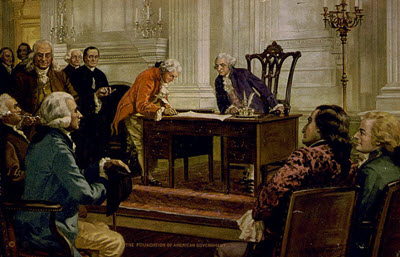
The Signing of the Constitution
On September 17, 1787, 39 of the 55 delegates attending the Constitutional Convention in Philadelphia, Pennsylvania officially adopted the Constitution. In order for the Constitution to go into effect, nine of the thirteen colonies or states had to adopt it. This ratification process set the stage for a great debate between those people who supported the Constitution and those who did not think it was the best plan for a government.
It was the Federalist Party that supported the Constitution and believed in a stronger central government. Federalists believed that a stronger government promoted economic development and public improvements like roads and canals. The Anti-Federalist Party feared a strong central government. They believed that a strong government was destructive of the rights of individuals, and limited the power of the states.
On June 21, 1788, New Hampshire became the ninth state to ratify the Constitution and the Federalists were victorious in the Constitution ratification debate. The Federalists were able to win in part because they were a better-organized group. The disagreements between the Federalists and the Anti-Federalists over the ratification of the Constitution, and more broadly the amount of power a federal or central government should have, set the foundation for the creation of the first two major political parties. A series of disagreements over policies of the new government would help better establish the beliefs of the two newly forming political parties.
Bank of the United States
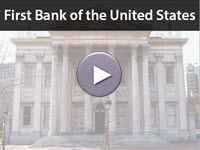 The debate over the development of a national bank helped create a new political party in the United States. Federalists viewed the bank as a way to strengthen the national government. The bank would allow the government to pay off debts and make needed public improvements. Anti-Federalists argued that the creation of a national bank would increase power over the states’ governments. In this interactivity, learn how the debates over a national bank helped create the Democratic-Republican Party. Click the player button to begin.
The debate over the development of a national bank helped create a new political party in the United States. Federalists viewed the bank as a way to strengthen the national government. The bank would allow the government to pay off debts and make needed public improvements. Anti-Federalists argued that the creation of a national bank would increase power over the states’ governments. In this interactivity, learn how the debates over a national bank helped create the Democratic-Republican Party. Click the player button to begin.
View a printable version of the interactivity.
The Jay Treaty
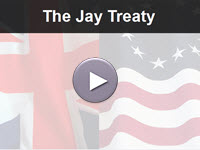 Beyond the shores of America, the ideas of the American Revolution had spread to France, causing a revolution to begin in that country. The revolution began when France declared war on England in 1793. Views involving America’s involvement in the French Revolution differed between the two political parties that were forming in America. For example, the Democratic-Republicans wanted to support France during their revolution. Conversely, the Federalists wanted to remain neutral in the conflict between England and France, and thus President Washington issued a Proclamation of Neutrality. In this interactivity, you will learn about the Jay Treaty and how America’s treaty with the British caused further division between the Federalists and Democratic-Republicans. Click the player button to begin.
Beyond the shores of America, the ideas of the American Revolution had spread to France, causing a revolution to begin in that country. The revolution began when France declared war on England in 1793. Views involving America’s involvement in the French Revolution differed between the two political parties that were forming in America. For example, the Democratic-Republicans wanted to support France during their revolution. Conversely, the Federalists wanted to remain neutral in the conflict between England and France, and thus President Washington issued a Proclamation of Neutrality. In this interactivity, you will learn about the Jay Treaty and how America’s treaty with the British caused further division between the Federalists and Democratic-Republicans. Click the player button to begin.
View a printable version of the interactivity.
The Undeclared War on France

America’s signing of the Jay Treaty and its unwillingness to repay debts caused the French to become very unhappy with the United States. The French government directed its navy and any private vessels to engage in conflict with American trading ships. After a number of American ships had been captured, Congress authorized the construction of a small navy and allowed citizens of the United States to fight back. This conflict, which occurred during John Adams' presidency, was called the undeclared war with France.
This unofficial war was another issue of disagreement between the Federalists and the Democratic-Republicans. The Federalists supported fighting back against France. The Democratic-Republicans wanted to stop the fighting by siding with the French, instead of the English.
John Adams
![]() After two terms as president, George Washington decided not to run for election again. This created an opportunity in 1796 for the first contested election between the two political parties. The Federalists selected John Adams, George Washington’s Vice President, as their candidate and the Democratic-Republicans selected Thomas Jefferson as their candidate. After a campaign filled with debate over the Bank of the United States and the Jay Treaty, Adams defeated Jefferson by three Electoral College votes. Adams became the second president of the United States and retained the presidency for the Federalist Party. View John Adams – 60-Second Presidents from eMediaVASM to become more familiar with the second president of the United States.
After two terms as president, George Washington decided not to run for election again. This created an opportunity in 1796 for the first contested election between the two political parties. The Federalists selected John Adams, George Washington’s Vice President, as their candidate and the Democratic-Republicans selected Thomas Jefferson as their candidate. After a campaign filled with debate over the Bank of the United States and the Jay Treaty, Adams defeated Jefferson by three Electoral College votes. Adams became the second president of the United States and retained the presidency for the Federalist Party. View John Adams – 60-Second Presidents from eMediaVASM to become more familiar with the second president of the United States.
Election of 1800
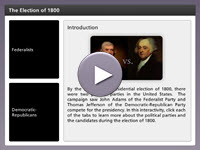 During the presidential campaign of 1800, the candidates debated the issue of taxes. Taxes were needed to pay for the undeclared war with France. The American public sided with the Democratic-Republican Party candidate Thomas Jefferson on this issue. This presidential election was significant, because it represented the first time in American history that power peacefully shifted from one political party to another. Click the player button to begin.
During the presidential campaign of 1800, the candidates debated the issue of taxes. Taxes were needed to pay for the undeclared war with France. The American public sided with the Democratic-Republican Party candidate Thomas Jefferson on this issue. This presidential election was significant, because it represented the first time in American history that power peacefully shifted from one political party to another. Click the player button to begin.
View a printable version of the interactivity.
Thomas Jefferson
![]() Third president of the United States Thomas Jefferson took part in two revolutions and is considered one of the Founding Fathers of the United States. After winning the election of 1800, Jefferson wanted to control the growth and strength of the Federal Government. View Thomas Jefferson – 60-Second Presidents from eMediaVASM to learn about the accomplishments of Thomas Jefferson.
Third president of the United States Thomas Jefferson took part in two revolutions and is considered one of the Founding Fathers of the United States. After winning the election of 1800, Jefferson wanted to control the growth and strength of the Federal Government. View Thomas Jefferson – 60-Second Presidents from eMediaVASM to learn about the accomplishments of Thomas Jefferson.
The First Political Parties Review
![]()
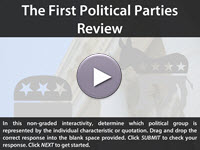 Now that you have investigated the development of the first political parties, complete this activity to check your knowledge. In this non-graded interactivity, determine which political group is represented by the individual characteristic or quotation. Drag and drop the correct response into the blank space provided. Click the player button to get started.
Now that you have investigated the development of the first political parties, complete this activity to check your knowledge. In this non-graded interactivity, determine which political group is represented by the individual characteristic or quotation. Drag and drop the correct response into the blank space provided. Click the player button to get started.